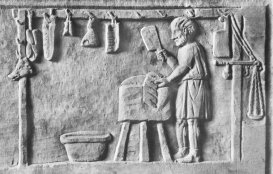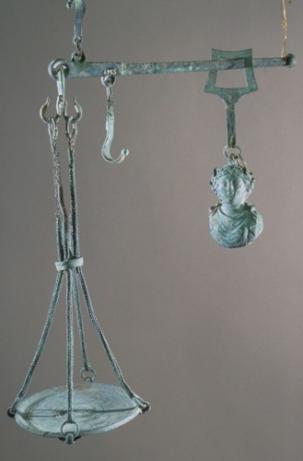Funding Institutions
Excellence Cluster 264 Topoi

Research Group Leader Jochen Büttner
In the course of this project, the development of the unequal-armed balance will be examined as a case study of an innovation process. The study will model this process on the basis of existing material evidence and will interpret it by reconstructing the historical circumstances under which it arose.
The unequal-armed balance, the practical experience gained in its use, and the knowledge born of this experience not only served as midwife at the birth of the science of mechanics in the 4th century BC, but also closely accompanied its development for more than 2000 years. Despite the importance of the former to the birth and subsequent molding of the latter, there is a dearth of research on the emergence of the unequal-armed balance, the dynamics of its development and the resulting technical knowledge in antiquity and late antiquity. This is all the more remarkable considering that the unequal-armed balance was presumably the most widespread and frequently used mechanical precision instrument in antiquity and late antiquity. The number of surviving artifacts is correspondingly large. It is precisely the large number of extant and relatively well documented artifacts, supplemented by textual and iconographic sources, that makes the unequal-armed balance a suitable model for a paradigmatic study of the origin, dynamics and development of technological innovations and the cultural conditions and effects of these innovations in antiquity and late antiquity.

Roman steelyard circa 79 CE, found in Pompeii |Source: Naples, National Archaeological Museum. Inv. No. 5569. Photo: Jochen Büttner.
The project scans the artifacts preserved in museums and uses the models to obtain the relevant data without the need of extensive measurements on the often fragile objects. In striving to apply models and concepts developed in recent innovation research on antiquity and late antiquity, this project aims both to arrive at a clearer understanding of the processes by which technology developed in this era and to contribute to the development of a general theory of innovation.
The research goal of the project is to answer the following central questions:
This project is divided into two main strands: the first investigates the material basis, i.e., the surviving artifacts, while the second explores the production, distribution and usage context. The artifacts will be studied in two mutually supportive campaigns, one of a diachronic, the other of a synchronic, character. The diachronic campaign will conduct the most complete assessment possible of all extant unequal-armed balance up to the 8th century AD in a suitable electronic format. The goal is to create an empirical basis for the modeling of the innovation process by which the unequal-armed balance developed. The synchronic campaign will work towards a detailed evaluation of all of the balances found in Pompeii, including their relevant characteristics. The goal here is to create an empirical basis on which to answer the question what variations of the unequal-armed balance can be shown to have been used at a given time, and what (knowledge) processes underlie these variations.
The “context” project strand investigates the spatially and temporally varying contexts in which the unequal-armed balance was produced, distributed and used and which form the background of the innovation process undergone by these technological artifacts. With regard to the production context, particular attention will be given to determining which of the unequal-armed balance’s components, e.g., the suspension hooks, and which production techniques are encountered in other areas of ancient and late-ancient technology, and what conclusions can be drawn on this basis, e.g. regarding the coevolution of different technological artifacts. The unequal-armed balance is embedded in an economic context in two ways. On the one hand, it is an instrument for regulating economic processes; on the other, it is obviously itself a product. The cartographical information on the spread of innovations obtained in the “material basis” project strand will be correlated with knowledge concerning resource management, markets and the flow of goods in antiquity and late antiquity, so that the economic contexts relevant to clarifying the distribution of balance finds can be identified. Conclusions regarding the use of the unequal-armed balance will be drawn on the basis of the objects themselves. Thus, for example, the weighing capacities of extant artifacts will be analyzed in connection with sample weights. On the other hand, the usage context will be reconstructed based on surviving written sources. Particular attention will be given, e.g., to ancient miscellany containing references to weighing practices